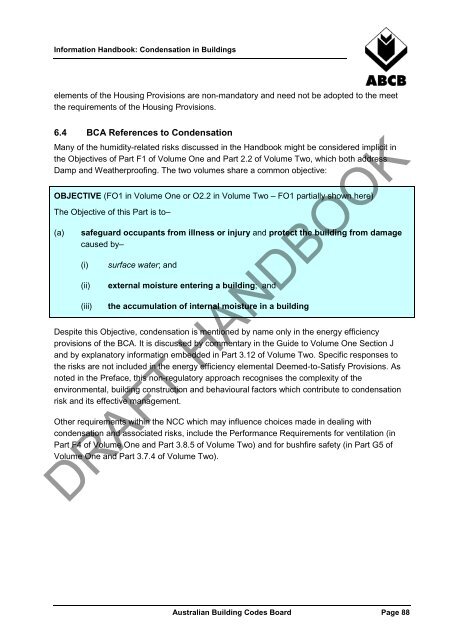Condensation in Buildings - Australian Building Codes Board
Condensation in Buildings - Australian Building Codes Board
Condensation in Buildings - Australian Building Codes Board
Create successful ePaper yourself
Turn your PDF publications into a flip-book with our unique Google optimized e-Paper software.
Information Handbook: <strong>Condensation</strong> <strong>in</strong> Build<strong>in</strong>gs<br />
elements of the Hous<strong>in</strong>g Provisions are non-mandatory and need not be adopted to the meet<br />
the requirements of the Hous<strong>in</strong>g Provisions.<br />
6.4 BCA References to <strong>Condensation</strong><br />
Many of the humidity-related risks discussed <strong>in</strong> the Handbook might be considered implicit <strong>in</strong><br />
the Objectives of Part F1 of Volume One and Part 2.2 of Volume Two, which both address<br />
Damp and Weatherproof<strong>in</strong>g. The two volumes share a common objective:<br />
OBJECTIVE (FO1 <strong>in</strong> Volume One or O2.2 <strong>in</strong> Volume Two – FO1 partially shown here)<br />
The Objective of this Part is to–<br />
(a)<br />
safeguard occupants from illness or <strong>in</strong>jury and protect the build<strong>in</strong>g from damage<br />
caused by–<br />
(i)<br />
(ii)<br />
(iii)<br />
surface water; and<br />
external moisture enter<strong>in</strong>g a build<strong>in</strong>g; and<br />
the accumulation of <strong>in</strong>ternal moisture <strong>in</strong> a build<strong>in</strong>g<br />
Despite this Objective, condensation is mentioned by name only <strong>in</strong> the energy efficiency<br />
provisions of the BCA. It is discussed by commentary <strong>in</strong> the Guide to Volume One Section J<br />
and by explanatory <strong>in</strong>formation embedded <strong>in</strong> Part 3.12 of Volume Two. Specific responses to<br />
the risks are not <strong>in</strong>cluded <strong>in</strong> the energy efficiency elemental Deemed-to-Satisfy Provisions. As<br />
noted <strong>in</strong> the Preface, this non-regulatory approach recognises the complexity of the<br />
environmental, build<strong>in</strong>g construction and behavioural factors which contribute to condensation<br />
risk and its effective management.<br />
Other requirements with<strong>in</strong> the NCC which may <strong>in</strong>fluence choices made <strong>in</strong> deal<strong>in</strong>g with<br />
condensation and associated risks, <strong>in</strong>clude the Performance Requirements for ventilation (<strong>in</strong><br />
Part F4 of Volume One and Part 3.8.5 of Volume Two) and for bushfire safety (<strong>in</strong> Part G5 of<br />
Volume One and Part 3.7.4 of Volume Two).<br />
DRAFT HANDBOOK<br />
<strong>Australian</strong> Build<strong>in</strong>g <strong>Codes</strong> <strong>Board</strong> Page 88
















